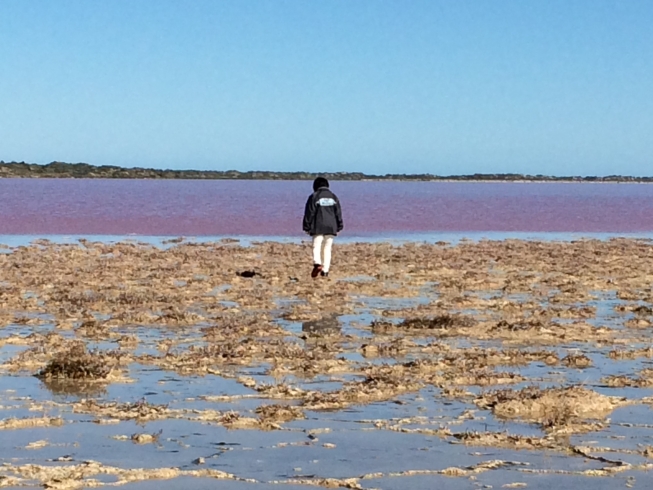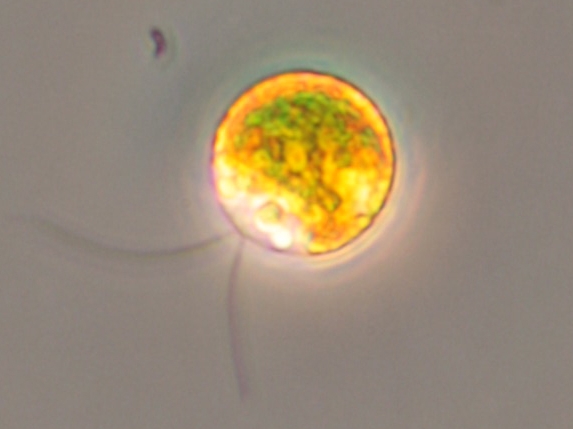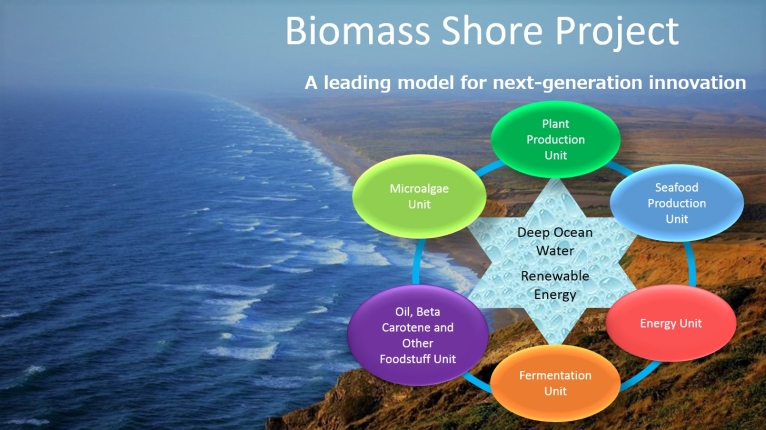The “Biomass Shore” Project

Contributed by Midori Kurahashi
Project Associate Professor
Graduate School of Agricultural and Life Sciences
http://biomass.html.xdomain.jp/english.html
The potential applications of microalgae, living creatures that share characteristics with both microorganisms and plants, have caught the eye of Project Associate Professor Kurahashi. She is making plans to test their potential in the creation of a sustainable society—a society in which the pursuit of industrial activities can be achieved while also reducing CO2 emissions. Here, we invite you to become acquainted with the “grand design” she has cultivated for the use of microalgae, specifically the genus Dunaliella, which combines deserts with deep ocean water and geothermal energy.

The Intergovernmental Panel on Climate Change (IPCC) warns that global warming will have irrevocable adverse effects on human society and our planet’s ecosystems unless necessary countermeasures are implemented at once. Despite this, we are still yet to take any effective anti-climate change measures. Homo sapiens is said to have a well-developed cerebrum, but have our brains not evolved to the point where we can solve this issue? As a humble member of Homo sapiens, let me put this question to rest by introducing the “grand design” that I have devised and named “Biomass Shore.”

Since removing high concentrations of CO2 from the Earth’s atmosphere is one crucial task in countering climate change, we must think in terms as large as the forests of the great Amazon jungle. However, it is difficult to grow terrestrial plants on such a massive scale. As an alternative, we can use the desert to cultivate large quantities of photosynthetic microorganisms called microalgae that will absorb CO2. At the same time, we can promote industry in adjacent areas.
Specifically, we can use renewable energy to pump deep ocean water into the desert. The water will then be separated into concentrated seawater and fresh water by the use of the temperature differential between the cold thermal energy of deep ocean water and geothermal energy (low-temperature geothermal energy is sufficient). We can also generate electricity by utilizing this temperature difference. In the desalination projects using this method that have been implemented in the Middle East and other regions, the concentrated seawater is disposed of. In the Biomass Shore project, however, this seawater will be used to fill large-scale paddy fields to be developed in coastal deserts for growing Dunaliella, a type of microalgae that does well in concentrated seawater. Deep ocean water contains nitrogen, phosphorous and other elements at concentrations several dozen times higher than those found in surface seawater, and these substances will serve as fertilizer to foster the growth of the algae.
Lipids extracted from Dunaliella can be used as edible oils and fats, as well as raw materials for chemical products. The lipids can also be converted by chemical processing into fuel oil whenever needed, such as, for example, when the price of crude oil goes up dramatically. Further, protein generated by Dunaliella has been proven to enhance the quality of feed and can be supplied to the “seafood production unit,” which I will describe later. Moreover, Dunaliella produces a large amount of carbohydrates in the form of glycerin, which can be used as a fermentation material. Fermentation has been developing into a large industry through the production of enzymes for industrial and other uses, creating a high demand for carbohydrates used in the fermentation process. The vast amount of glycerin produced by Dunaliella would be attractive enough for companies engaged in commercial fermentation to establish bases in coastal deserts. Residues from the fermentation process could then be recovered from these desert bases so that the nitrogen and phosphorous contained in them could be used as additional fertilizer for Dunaliella.
Specifically, we can use renewable energy to pump deep ocean water into the desert. The water will then be separated into concentrated seawater and fresh water by the use of the temperature differential between the cold thermal energy of deep ocean water and geothermal energy (low-temperature geothermal energy is sufficient). We can also generate electricity by utilizing this temperature difference. In the desalination projects using this method that have been implemented in the Middle East and other regions, the concentrated seawater is disposed of. In the Biomass Shore project, however, this seawater will be used to fill large-scale paddy fields to be developed in coastal deserts for growing Dunaliella, a type of microalgae that does well in concentrated seawater. Deep ocean water contains nitrogen, phosphorous and other elements at concentrations several dozen times higher than those found in surface seawater, and these substances will serve as fertilizer to foster the growth of the algae.
Lipids extracted from Dunaliella can be used as edible oils and fats, as well as raw materials for chemical products. The lipids can also be converted by chemical processing into fuel oil whenever needed, such as, for example, when the price of crude oil goes up dramatically. Further, protein generated by Dunaliella has been proven to enhance the quality of feed and can be supplied to the “seafood production unit,” which I will describe later. Moreover, Dunaliella produces a large amount of carbohydrates in the form of glycerin, which can be used as a fermentation material. Fermentation has been developing into a large industry through the production of enzymes for industrial and other uses, creating a high demand for carbohydrates used in the fermentation process. The vast amount of glycerin produced by Dunaliella would be attractive enough for companies engaged in commercial fermentation to establish bases in coastal deserts. Residues from the fermentation process could then be recovered from these desert bases so that the nitrogen and phosphorous contained in them could be used as additional fertilizer for Dunaliella.

As thus far explained, the grand design incorporates all that is required for the cultivation of terrestrial plants: sunshine, fresh water and fertilizer. These three factors present an economic advantage for establishing large-scale “plant production units” in coastal deserts. Moreover, multi-stage “seafood production units” would also be established in these areas, utilizing the features of deep ocean water. Ammonia contained in wastewater produced by the seafood production units would be used to supply nitrogen to large algae, from which mannitol could be extracted and supplied to the “fermentation units.” Then, the hydrogen generated in the fermentation process would be delivered to the “energy units.”
In this manner, we could use untapped resources, including coastal deserts, deep ocean water, microalgae and geothermal energy, to organically combine the units for microalgae production, plant production, fermentation, seafood production, energy production and possibly others, forming a biomass complex. This project provides a model for a sustainable society and, if it is implemented, it will help create a society in which we can continue to carry out industrial activities while reducing our CO2 emissions.
Note: This article was originally printed in Tansei 34 (Japanese language only). All information in this article is as of March 2017.
In this manner, we could use untapped resources, including coastal deserts, deep ocean water, microalgae and geothermal energy, to organically combine the units for microalgae production, plant production, fermentation, seafood production, energy production and possibly others, forming a biomass complex. This project provides a model for a sustainable society and, if it is implemented, it will help create a society in which we can continue to carry out industrial activities while reducing our CO2 emissions.
Note: This article was originally printed in Tansei 34 (Japanese language only). All information in this article is as of March 2017.








